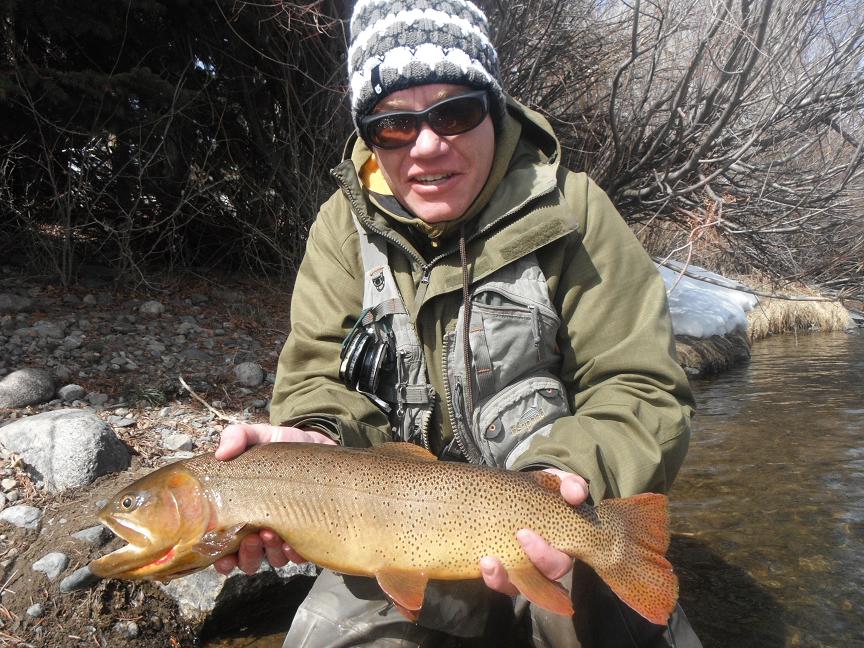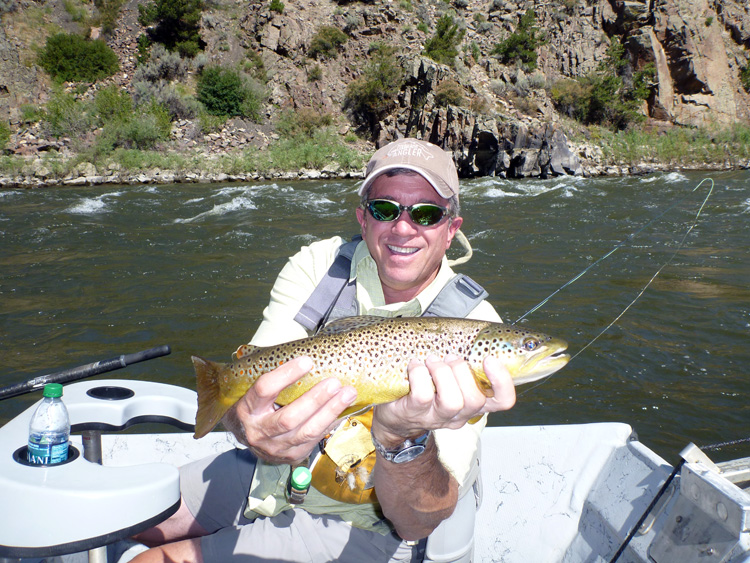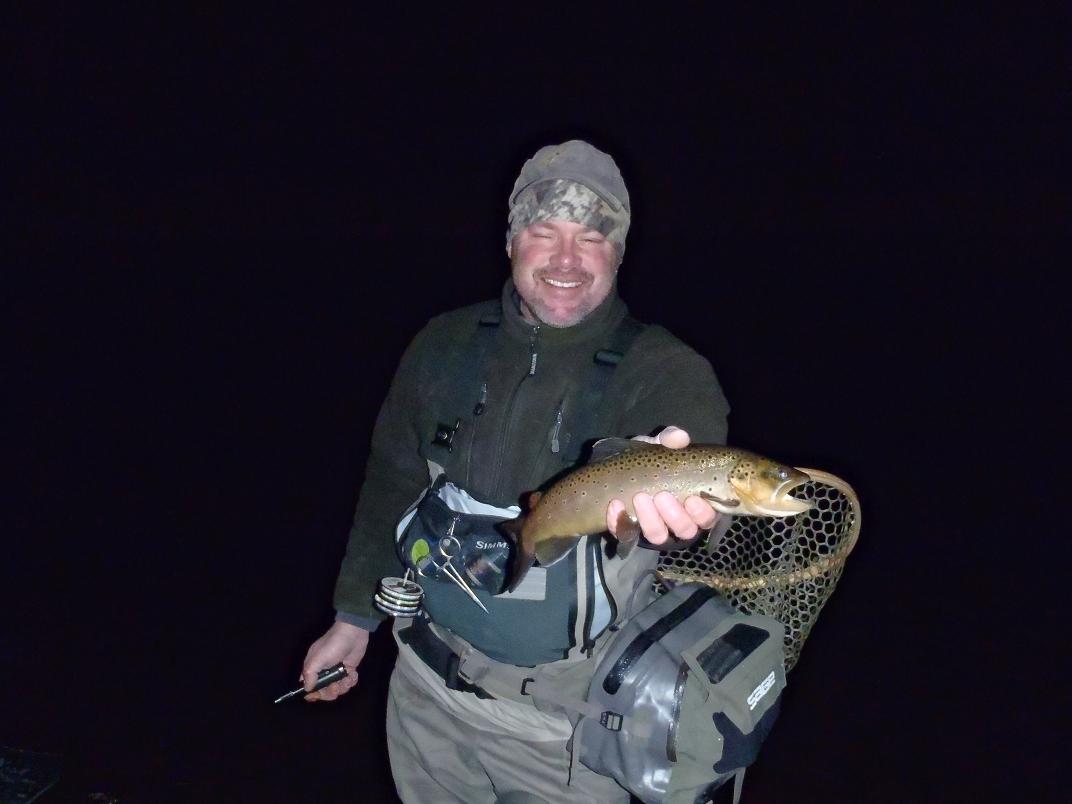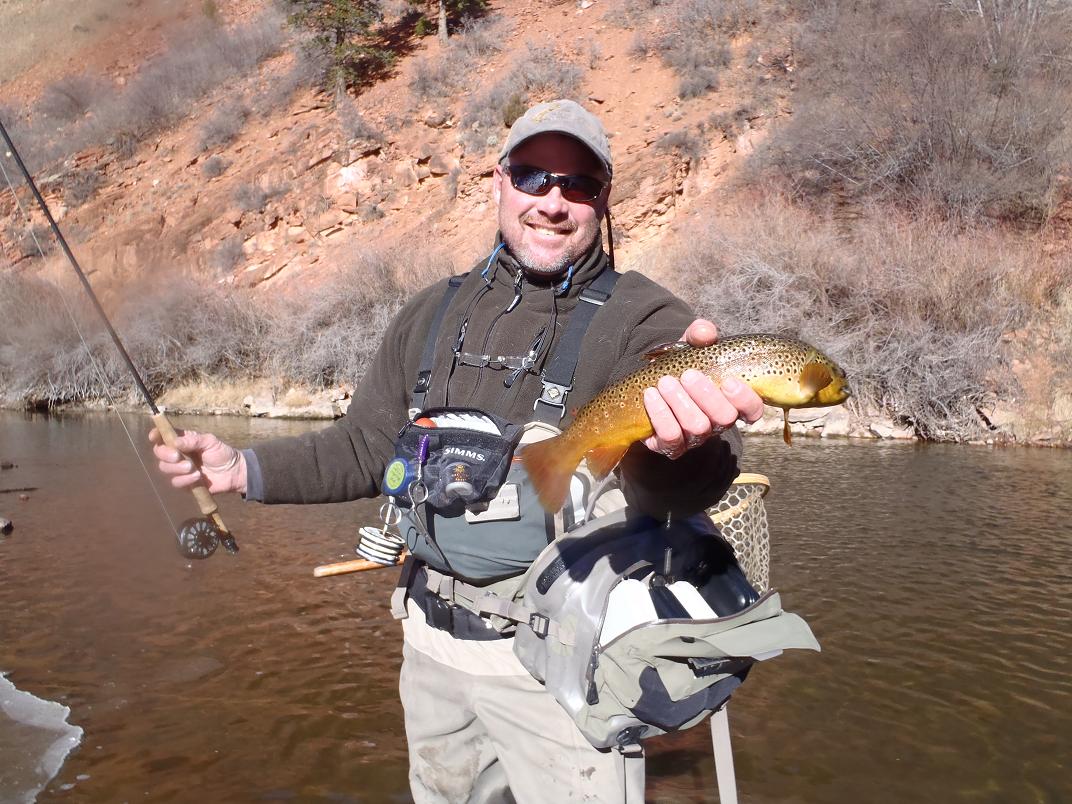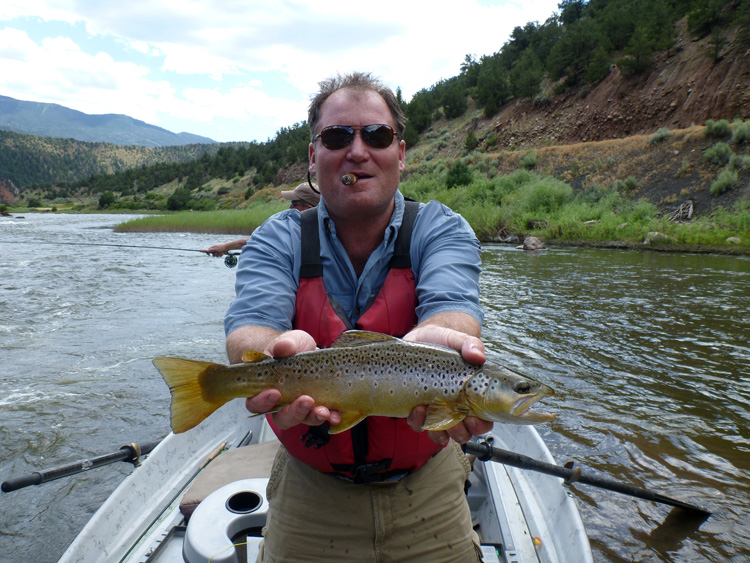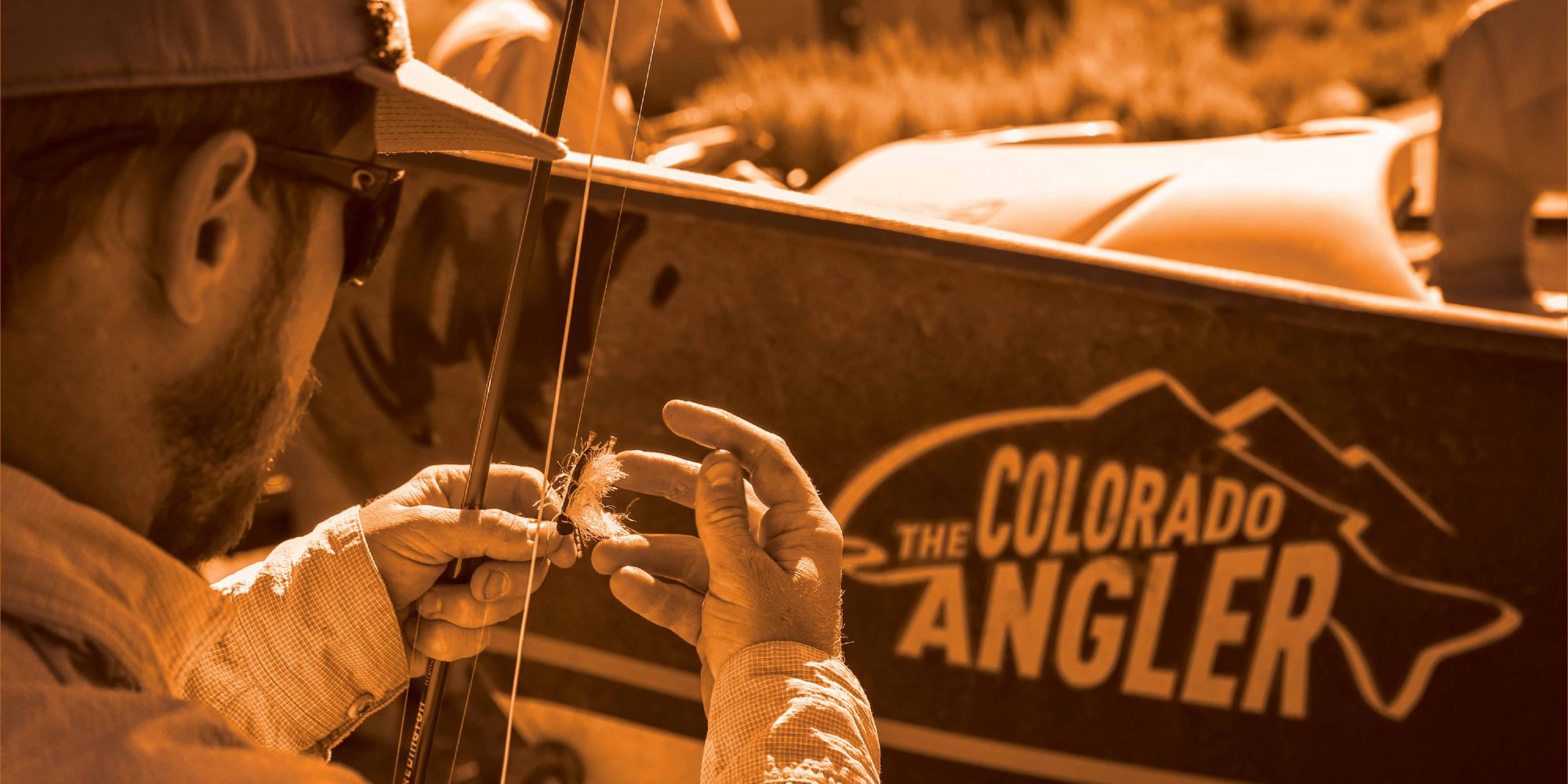 Book Your Guide Trip Now Book Your Guide Trip Now
After a very warm weekend, most rivers in the central part of the state have seen a return to increasing flows. It looks as if Run-Off is upon us and may soon peak. We all know that Run-Off can mean disruptions in the stability of water quality. Keep an eye on this page and we will keep you up to date on volume and clarity conditions.
One disruption of note is here in town on the Blue. Straight Creek, which dumps in just above the Highway, has brought a noticeable change to the normally stable Tailwater fishery in Silverthorne. For complete details check out our blog post from Monday regarding the situation.
There are still options out there to get your fish on, and not just on still water destinations. The Colorado River from Radium on up into Beyer’s Canyon is currently running well below average, as water managers store or ship out every available drop of water in the river.
The Salmonfly hatch is still in the emerging stage in the upper stretch above Parshal and through Beyer’s. Weekend action was very steady and should continue into the middle part of this week. After that we should see some residual adults hanging around for a few more days, keeping the opportunistic trout looking to the surface for an easy meal.
Further down, in Gore Canyon, there is still some fantastic action for the remaining adult Salmonflies in the interior of the Canyon. The sheer number of bugs this weekend was incredible, the comparison we heard that stood out the most was “as thick as any Mother’s Day Caddis hatch I have ever seen.” Now that is saying something.
Keep in mind that it does still remain volatile at times during this time of year and you want to be flexible, ready to change course if needed.
Don’t hesitate to call us for current conditions, we’ll do our best to try and interpret changing stream flow readings with you. Or follow us on Twitter @coloradoangler, where we try to post changing conditions as we learn about them.
Detailed reports on the right side of this page will give more specific information on a particular stretch of river. Make sure to check those out for your river of interest, as they will be able to answer questions pertaining to hatches and flies.
Please feel free to call us at The Colorado Angler, at any time to discuss any questions and concerns you may have about the current conditions. There is a lot of information here on this page as well as on our main page at www.TheColoradoAngler.com but, space is limited and we may not have answered all of your questions. We want to make sure you get the information you are looking for. Toll Free 855-CO TROUT (268-7688) or stop by and see us in the Summit Place shopping center in Silverthorne, next to Blue Moon Bakery, Exit 205 on I-70, then south 1 block. Spring Hours: Monday – Saturday 8 am – 6 pm, Sunday 8 am – 5 pm
|
Blue River Below Dillon Reservoir
|
 |
| Flow: 55 cfs. |
| Conditions: As mentioned in our blog post regarding the Blue River blowout, there has been a sudden change to river conditions here in Silverthorne. It looks as if Straight Creek flows may have peaked and should hopefully start to recede in the next few days. With this current situation, we will see a dramatically different look to the river. Clarity below the confluence of the two streams will be off color to down right dirty depending on the time of day. In the morning will be the best time of day to fish below the mix as inflow from the creek is at it’s low mid-morning. While it may be off color, there will still be a foot or greater visibility at times and there is still some success to be had. Focus on the traditional dirty water nymphs like beaded searching patterns along with Egg Patterns and San Juan Worms. As the day moves into afternoon, clarity will continue to drop and at some point you will need to move upstream above the mix. The water above Straight Creek remains low and gin clear and fishing continues to impress as both resident fish along with the recent plants from CPW remain very active. The typical small Tailwater Midge and Mayfly nymphs will be the core of the action along with the occasional early morning Midge hatch. Crowds will definitely be brisk as the majority of anglers will be on the clean water. Stay patient, this should hopefully start to clear in a few days.
Town Flies: Spaghetti and Meatballs (San Juan Worm Patterns and Eggs) Candy Cane #20, BTS Mysis #16-22, RS-2 #22-24, STD Baetis #20, Black or Chocolate UV Emerger #22-24, Kingery’s Cap’n Hook #20-22, Pure Midge Larva #20-24, Black Beauty #20-24, Tube Midge Black or Red #20-22, Medallion Midge #22-24, Split case BWO #20, Winter Baetis #20-22, Desert Storm #20-24, Rainbow Warrior #20, #22 BWO Adult, Adult Midge Dark, Brook’s Sprout Midge #22-24, Parachute Adams #24-26 .
|
Blue River Below Green Mountain
|
 |
| Flow: 73 cfs. |
| Conditions: Look for these low flows to continue through the end of June at the earliest as water managers will try and hold off on releasing any water from here until it is absolutely necessary. That is not entirely a bad thing however, as low water means incredible wading access and range in the canyon. While action has not been fast and furious, as fish have been rather skittish with such low flows, this might still be a great opportunity to target some of the deepest runs in the river, which often make it tough to cover under higher flows. The majority of current activity will be to Midge and Baetis nymphs, with a good possibility of an emergence coming in the form of a Blue Winged Olive hatch. As always down here, don’t overlook the larger nymphs in the system, as we find fish throughout the year will still capitalize on a hearty offering when presented well. Try running a double nymph rig with a larger bead head for the Green Drakes or Stoneflies that are well established in the Canyon, followed up with either a Baetis or Midge pattern for a more timely offering.
Flies: Big bead heads: Hare’s Ear, Tungteaser, Pheasant Tail, Stubby Stone, Twenty Incher, Rubberlegs, Psycho prince. Smaller Hatches: Juju Baetis (Standard and Purple), Barr’s Emerger BWO, Redemption BWO, Split Case BWO, Tung Psycho May BWO, Baetis Big Bear, Zebra Midge, Rojo Midge, Pure Midge Larva, Jujubee, Biot Midge, UV Emerger, CDC BWO Comparadun, Winger Parachute BWO, Sparkle Baetis
Floaters should note: Floating is done for the season, river levels are much too low. The river volume on this stretch of water can change on an infrequent schedule and often. It is important to know the flow before you launch and make an honest assessment of your ability and watercraft capability. Please respect private property rights along the river.
|
Colorado River Above Kremmling (Parshall)
|
 |
| Flow: 200 cfs. |
| Conditions: The Salmonflies have arrived. Adult Pteronarcys have been hatching in good numbers for the past couple of days and the response to them has been fantastic. We area seeing the big bugs present throughout all of the public access points from Reeder Creek up into Beyer’s Canyon. Stream flows are unseasonably low and that makes for some great wade fishing although, it will have an effect on some of the more traditional approaches to throwing dries this year. Adult Salmonflies spend a great deal of time in the bushes adjacent to the river, where they are prone to falling in the water and creating a feeding opportunity for waiting trout. With these below average flows, there are many banks where the water doesn’t come close to the bushes. In turn leaving many clumsy Stoneflies safely on dry rocks when they fall. Where you can, concentrate on the edge water where there is a slight bit of depth for trout to hold in. Also look to focus on pockets, seams and riffles and ledges where possible. Early in the day may be a little slow to start but, once the sun of the day warms things up, look for adults to be in the air and trout to increase their focus on the surface. The best action will come from noon until early evening so, don’t give up too soon. This hatch is short lived, generally lasting from 5 to 12 days. Do yourself a favor and get there quick. If you have never experienced this emergence, it is quite the show.
Flies: Half-Cocked Salmonfly, B-1 Bomber, Rogue Foam Stone, Sofa Pillow, Clark’s Salmonfly, Chubby Pteronarcys, Loco Stone, Fuzzy Wuzzy Orange, Kaufman Stone Nymph, Pat’s Rubber Legs in Orange/Brown, Brown/Black and Black. Hot Wire Caddis, Barr’s Graphic Caddis, Z Wing Caddis, CDC Caddis Emerger, Stimulator, Pearl and Elk Caddis, Ginger Variant, Slumpbuster, LE Marabou Streamer.
|
Colorado River Pumphouse to Dotsero
|
 |
| Flow: 520+/- cfs. |
| Conditions: Starting to see the Salmonfly hatch wane as the emergence is over and what bugs remain are adults. Still having some good action on adult imitations, it is just fewer and farther between. Best bet for continued success on this marvelous hatch will be in the canyon water of Gore and Little Gore, with a little residual action in the Pumphouse area. If you are looking to throw dries, it will still be a little slow to start in the morning as the bugs will hang tight in the bushes. Then as the day moves into afternoon work the riffles, pockets, seams and any edge water that has a little depth to it with adult imitations. Stream flows are exceptionally low for this time of year and wade access is very good, with multiple places that allow for crossing the main channel. Clarity is also fantastic at the moment with nearly 3 feet above the confluence with Sheephorn Creek, just above the Radium Bridge. Now as the Salmonflies start to fade out, look for other patterns to return to the diet for trout needing to maintain some of the weight they have started to put on. Standard bead head searching nymphs will once again do quite well, along with streamers and attractor dries. At these flows and water temperatures it won’t be long before we see the great summer hatches of PMDs. As you make your way downstream additional feeder streams are adding run-off and diminishing clarity, such as Sheephorn and Piney Creeks. Pay attention to these and be prepared to move higher upstream if visibility becomes to dirty but, there is plenty of great wade access between State Bridge and Rancho.
Flies: Large stones, Tungteaser, Rubberleg, Sexstones, Salmonfly dries: Designated Hitter, Fuzzy Wuzzy Orange, Half Cocked, B-1 Bomber, Clark’s Stonefly, Beaded Pheasant Tails, Beaded Hares Ears, RS2’s, Split Case BWO, Barr’s Emerger, Juju Baetis, Blue Ribbon Emerger. Gulper Special, BWO Sparkle Wulff, Winger Parachute, CDC Baetis Dun
|
Colorado Below Glenwood Springs
|
 |
| Flow 9870 cfs. |
| Conditions: Consider this done for the immediate future. Things have gotten to be pretty dirty on the lower river. With a combination of run-off from the lower Eagle and the Roaring Fork from the Crystal River downstream, this may take some time to clear. Not to mention that flows have jumped up considerably and the river will be gaining a certain amount of debris as it scours areas that have been dry. Definitely not a destination at this time. If you are in the neighborhood on your way to fish the Pan or Upper Roaring Fork, then give it a look but, by no means go out of your way for the risk at mostly dirty water. It’s a shame too, as huge Caddis hatches had been pouring off the river and fishing was solid.
Flies: Mr Peacock Ice, Pat’s Rubber Legs, Tungteaser, Bead Prince, Twenty Incher, Hunchback Green Drake nymph, Tungsten Pheasant Tail, Bead Prince, Bead Hares Ear, Zebra Midge, Rojo Midge, Poison Tung, Juju Baetis, STD Baetis, Tungsten Split Case BWO, Para Ext. Body BWO, Parachute March Brown, Gulpher Special, Various Egg imitations.
|
Arkansas River Above Buena Vista
|
 |
| Flow: 1600 ^cfs. @ Granite |
| Conditions: Stream flows are really starting to climb in the upper valley as snow melts begins to hit it’s stride. There are still a few options above Lake Creek where Twin Lakes dumps in but, they are limited and require covering some ground when you hit the river. Look for “soft” water along the banks and the insides of corners. Best action will be on nymph rigs with beaded searching nymphs and Stonefly imitations as well as casting streamers across any quite lies that you find and retrieving it cross current. Clarity will vary from day to day based on snow melt, with some days having good visibility early then clouding up as the day goes on. Once the rising water levels off, things should improve as water temps rise and push the Caddis to hatch. As you move down below Ball Town the flow is going to be above and beyond what is considered high although, there may still be an odd eddy or soft bank water here an there. It may be best to look to other safer bets.
Flies: Beaded Hares Ear, Hot Wire Prince, Beaded Pheasant Tail, Copper John, RS-2, Zebra Midge, Poison Tung, Jujubee, Juju Baetis, Barr’s BWO Emerger, Winter Baetis, Rojo Midge,WD40, Para Extended Body BWO, CDC Baetis Dun, Winger Parachute
|
Arkansas River Salida Area
|
 |
| Flow: 2200 ^ cfs. @ Wellsville |
| Conditions: Time to look for another spot for the time being. Flows are starting to jump up to late spring levels as runoff is adding volume to the river. Clarity will be a problem as long as the river is on the rise and continuing to gather additional debris. Once flows stabilize, maybe in another week or so, then the clarity should improve along with the fishing. We like to see it get back to that 1500 +/- flow after it peaks and then the float fishing can really turn on. That will be fish-able for wade anglers as well, it will just be limited to how much wading an angler can do at a given spot. Nymph rigs will be your best bet along with a well placed streamer tight to the bank in a break from the current. Large sized bead head searching patterns and stones should do the trick. Just something that looks like a good meal, presented to the fish where he shelters can be very productive. Be flexible and not afraid to move through some water in order to find good holding areas where the trout may be congregating.
Worth Noting: This is now the second year of a two year program to re-establish Pteronarcys Californica to the Arkansas. Over the past 2 years CPW has transplanted about 80 thousand Salmonfly nymphs from the Colorado River to the Arkansas and distributed them just above and below Salida. We are keeping an optimistic eye on the river here to see if this insect will take hold and produce a revived population. The next couple of weeks will be telling.
Flies: Bead Head Pheasant Tail # 14-16, Tungstone Golden #12-16, Tungsten Yellow Sally, Iron Sally, Chartreuse Copper John #12-16, Chartreuse Hot Wire Caddis, Hot Wire Prince, Pat’s Rubber Legs #8, Parachute Extended Body BWO, Juju Baetis, Split Case BWO, Zebra Midge, Garcia’s Rojo Midge, RS-2 and Poison Tung, Parachute Extended Body BWO, Winger Parachute, Sparkle Baetis, CDC Para Dun, High Vis Para Baetis, Elk Hair Caddis Olive, Tan or Brown, Stimulator, Hippie Stomper.
|
Roaring Fork River at Glenwood Springs
|
 |
| Flow: 3500-4800 cfs. |
| Conditions: Flows appear to be peaking or just about peaking, at this time. Conditions are tough with high water and no visibility. This will be a tough spot for the next week or so river wide. However, as things peak and start to recede, there will become pockets of opportunity along the upper river above Carbondale and into Basalt. The biggest influence in the valley in regards to water quality is the Crystal River, which dumps in at Carbondale. This will run high and off color longer than many other feeder streams of the river. So even if the the lower river persists in being murky there may be some decent locations up river. Keep an eye out for our report to change, as we will bring that information to you as soon as it happens.
Flies: Twenty Incher, Tungteaser, Stubby stones, Beaded Pheasant Tail, Standard Pheasant Tail, Pat’s Rubber Legs, Tungsten Juju Baetis, Psycho Mayfly, STD’s, Barr’s Emerger, BWO dries, Para Extended Bosy BWO, Zebra Midge, UV Emerger, Rainbow Warrior
|
South Platte River, Middle Fork
|
 |
| Flow: 300+/- cfs. |
| Conditions: Stream flows are up and slightly on the high side but, there is still some potential if you are willing to cover some ground. With the nature of this stream being shallow gradient as it winds through meadows, there are some good bends in the river that will offer a chance to get some flies in the water where fish are taking refuge from some of the faster runs. Nymphs will probably provide the best results but, it you want to give your self the potential for some surface activity, then a simple dry dropper set up should get you to most of the spots on the river and offer a mix of nymph and dry fly eats. We recommend fishing your way upstream with that type of rig using either a good sized attractor or small hopper on top and following it up with a beaded searching nymph. Then on your way back to the parking area, work the same water over with a streamer up against cut banks and across ledges.
Flies: Chartreuse Copper John, Rainbow Warrior, Egg Patterns, Hot Wire Prince, Beaded Flash Prince, Tungteaser, Autumn Splendor, Slumpbuster, Sparkle Bugger
|
South Platte, Dream Stream
|
 |
| Flow 165 cfs. |
| Conditions: Flows have been anything but stable here and are now again on the rise. We have seen a nice step up in flows over the past few days, which should be a big help to anglers and comfort the fish in the holding water. At the moment sight fishing is producing some modest results and we recommend going without an indicator if possible. Just one less thing to make the trout nervous. A deliberate, stealthy approach is going to be your best bet here. Be patient with your movements and try to spot a fish to target versus blind casting. The one positive to all of this is that it’s not blown out as some of our freestones now are. Caddis should start to emerge as daytime temps area now steady in the warm category. We’ll do our best to keep an eye on things here and post when the numbers and size of fish start to fill in.
Flies: Black Copper John #22, Juju Baetis, Zebra Midge Black/Silver, Buckskin Caddis, CDC Caddis Emerger, Caddis Candy, Caddis Larva, Barr’s Emerger PMD, Mercer’s Poxyback PMD, Poxybiot Nymph, Egg Patterns, Pure Midge Larva, Cap’n Hook
|
Williams Fork River Below Dam
|
 |
| Flow 17 cfs. |
| Conditions: Flow is down to minimal levels as we start to move into Spring and water allocations from the reservoir are depleted. Sufficient holding water will be reduced in many stretches and anglers intent on fishing this tailwater should really look to another fishery. At this flow stress levels in fish will be high enough. Any excessive pressure on them may be detrimental to the overall health of the river. Try to wait until we see a rebound in water in the river.
Flies: Pure Midge Larva, Rainbow Warrior, Rojo Midge, Biot mayfly Emerger, #20-22 Green Copper John, Zebra Midge, RS2’s, 5-0 Midge, UV Emerger, BWO dries.
|
Antero Reservoir
|
 |
|
| Conditions: Things are really starting to pick up as the Chironomid hatch is in full swing. Look for action to be strong on static nymph rigs with a mix of Chironomid and Calibaetis patterns fished either under an indicator or with a slow retrieve. Try varying your depths between 6 and 11 feet with a couple of different offerings to try and tune into what the fish are keying on. We like to fish a 3 fly rig mixed with alternating Midge/Mayfly/Midge. If you fish with a partner make sure to fish different colors for the Chironomid, in different sizes and depths. This will be the quickest way to see which depth and imitation the trout want most. Calibaetis are already popping just down valley at Spinney and won’t be far behind here. It is always a good method to mix some in to your attack as the trout can often be a little more aggressive to an insect as it first starts to get active prior to the hatch. With run off now having an impact on many stream access points, weekend traffic in particular has been very brisk so, be prepared to wait a few minutes at the inspection station if you are taking a boat.
Flies: Yankee Buzzer, Jumbo Juju, Tak’s Chironomid, Garcia’s Rojo Grande Midge, Rapunzel Damsel, Poxyback Calibaetis Nymph, Hare’s Ear, Copper John
|
Spinney Mountain Reservoir
|
 |
|
| Conditions: Despite all forecasts to the contrary, the boat ramp has opened for the season and trailer launching is now available. Not a moment too soon. Action on the lake has really started to happen. There is good success on both Chironomid and Calibaetis imitations, not only on nymphs but Adult Calibaetis as well. Anglers looking to target cruising risers can definitely do so when conditions allow and then go back to subsurface methods when the hatch is done or the wind picks up. Traffic has been brisk with the combination of good fishing and high rivers elsewhere but, the lake has plenty of surface to spread out on. Static nymph rigs are providing solid success with a combination of Calibaetis and Chironomid imitations fished from 5-11 feet depending on the time of day and weather. As we mention in the Antero report, we like to fish 3 flies under the indicator and be willing to mix up the patterns and depth until we find the right combo for the moment. Keeping in mind that the right combo can change over the course of the day as fish may change their appetite or the food changes it’s elevation.
Flies: Jumbo Juju, Tak’s Halo Midge, Yankee Buzzer, Poxyback Calibaetis, Birds Nest, Gaviglio’s Calibaetis Nymph, CDC Calibaetis Nymph, Hare’s Ear, Brook’s Sprout Calibaetis, Parachute Adams, CDC Calibaetis Spinner, Hale Bopp Leeches
|
Delaney Buttes Lakes
|
 |
|
Conditions: Starting to become a good option with many rivers getting higher and off color. Early season means fish tight-in, cruising the banks and a lot of the traffic has been from shore. Sight fishing can be productive when that is the case. Fish a couple of nymphs suspended under and indicator or slow crawl a smaller leech pattern to start.Flies: Egg Patterns, Bead Pheasant Tail, Bead Hare’s Ear, Copper John, Jumbo Juju, Zebra Midge, Tak’s Chironomid, Hale Bopp Leech
|
|
 Book Your Guide Trip Now
Book Your Guide Trip Now

